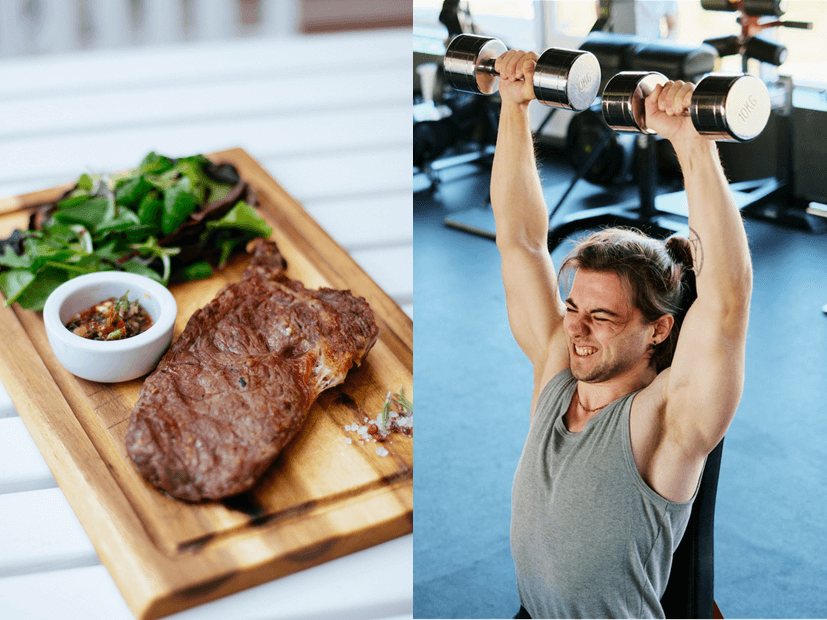We’re all familiar with the basic macros needed to sustain life: Carbohydrates, Proteins, and Fats. The Low-Carb diet, as evident from its name, entails a reduced consumption of carbohydrates.
People choose to follow the low-carb diet plan for a multitude of reasons. They should shed a few extra pounds efficiently and eliminate the grogginess that comes with consuming carbs. Perhaps some individuals wish to manage their glucose levels or prevent diseases such as Fatty Liver, Metabolic Syndrome, and Diabetes. Whatever the reason, the low-carb diet has proved beneficial when done in a balanced manner.
We’re here to investigate the intricate relationship between carbohydrates and your workouts.

How to Mix a Low-Carb Diet and Exercise?
When starting a low-carb diet, your body needs time to adjust to burning fat instead of carbs, which may lead to lethargy, fatigue, and cravings. Although your metabolism will adapt after a few weeks, it’s important not to stress your body during this period. Recent studies suggest that a low-carbohydrate or ketogenic diet may help athletes improve their aerobic and anaerobic performance and overall strength. Even when compared to a typical high-carbohydrate diet, many athletes utilize.

- Firstly, you should start slow and not dive into a binge; break your fast with a nutritious liquid like broth to get those digestive juices going.
- Secondly, try consuming leafy greens and fibrous vegetables to break your fast, and try to consume your food slowly in small bites.
- Finally, avoid breaking your fast with carbs, cruciferous vegetables, dairy, eggs, and nuts since these can potentially cause digestive distress in the initial phase of breaking a fast.
What Are the Best Workouts to Do on a Low-Carb & Keto Diet?
The best fitness exercises for the keto diet are those that work alongside your body's fuel system. Because your body is changing from using glucose to ketones for fuel, high-intensity anaerobic exercises may feel more challenging initially. But with the proper approach, aerobic and resistance training can be extremely effective.

1. Weightlifting & Resistance Training
Weightlifting is the best workout for the keto diet. It helps preserve lean muscle mass, improves body composition, and supports long-term weight loss.
While glycogen stores are lower on keto, your body adapts over time by becoming more efficient at using ketones for fuel. Focus on compound movements like squats, deadlifts, bench presses, and rows. Maintain reps in the moderate range (6–12) and take longer rest between sets if you're running low on energy.
2. Steady-State Cardio
Keto cardio can be a game-changer for burning fat and the health of your heart. Steady-state cardio, such as walking, jogging, cycling, or swimming at a moderate speed, uses mainly fat for fuel, making it the perfect exercise for keto-adapted bodies. 30–45 minutes of moderate-intensity activity, 3–5 times per week.
Morning fasted walks are an excellent way to enhance fat oxidation. The National Institutes of Health demonstrate strong evidence that shows aerobic training works well with ketogenic diets. This combination can improve metabolic health and performance.
3. Interval Training (HIIT)
High-Intensity Interval Training (HIIT) is best exercise on a keto diet. HIIT includes short bursts of intense activity followed by rest periods. This approach helps burn fat while keeping muscle.
Keep your workout sessions short, around 15 to 25 minutes, to prevent running low on glycogen. Most of your energy will come from fat, but intense movements can use glycogen, so it's important to pay attention to how well you perform and recover.
4. Pilates and Flexibility Workouts
Not every workout needs to push your limits. Pilates, yoga, and stretching routines improve flexibility, core strength, and mind-body connection, all of which are valuable during keto adaptation and excellent for active recovery days.
Pilates and flexibility workouts assist in decreasing muscle soreness and enhancing mobility. These best exercises on keto can be a stress-reducing, exercise-supporting activity that does not put excessive demands on your depleted carb stores.
5. Running (with a Plan)
Running is still okay with keto workouts, but it does involve some planning. Long-distance running at a slow pace is fine when you are in ketosis. However, if you want to sprint or race, you will need to use carb cycling or take supplements like electrolytes and MCTs. Running is good for your aerobic capacity and heart health. Just be careful and pay attention to signs like fatigue or dizziness, as these may mean you need to take care of your health and well-being or take some time to rest.
6. Cycling for Endurance and Agility
Cycling, indoor or outdoor, is an excellent workout for the keto diet that combines endurance, balance, and strength. It improves blood circulation, supports your leg and core muscles, and enhances energy levels throughout your fitness journey.
Whether you enjoy long road rides or stationary cycling at the home gym, it’s one of the best ways to maintain cardiovascular health while staying in ketosis. Use electrolyte-rich keto products to stay hydrated and prevent fatigue during longer sessions.
7. Bodyweight Circuit Training
Bodyweight workouts are versatile, accessible, and ideal for keto exercise for anyone who wants a complete fitness session without heavy equipment. Home circuits like push-ups, lunges, planks, and squats improve agility, mobility, and total-body strength.
Because these movements rely on endurance and control, they work well with a low-carb workout plan and help maintain lean muscle without over-taxing glycogen stores. Adjust intensity based on your energy levels and progression.
What Should You Keep in Mind When Exercising on a Keto Diet?
Before adding any workout to your daily routine, consider the following exercise tips:
1. Electrolyte Balance is Important
Low-carb diets tend to purge sodium, magnesium, and potassium naturally. If you don't have sufficient amounts of these, exercise performance will be compromised, and you can feel weak or dizzy.
2. Monitor Your Protein Intake
While the ketogenic diet is low-carb and high-fat, don't neglect protein. Sufficient protein helps repair and build muscle tissue, particularly valuable for resistance and anaerobic training.
3. Be observant of the Adaptation Phase
Many people feel weak during the first few weeks of keto. This is normal, as your body would adapt. Give it time before pushing your workouts too hard.
According to research, full keto-adaptation can take 4–6 weeks. During this phase, focus on low to moderate-intensity activities.
Final Advice for Keto Fitness Success
If you’ve ever wondered, “Can you work out on keto?” — absolutely yes. The key is listening to your body, balancing nutrition with fitness, and adjusting intensity based on your recovery and energy levels.
Choose exercises that align with your lifestyle, from steady cardio to resistance training and mindful flexibility sessions. Whether you’re an athlete, a woman looking for balance, or simply seeking to improve your wellness, combining a keto workout with proper care will support your overall health, metabolism, and performance.
Frequently Asked Questions
Can I build muscle on a keto diet?
Yes, with sufficient protein and appropriate resistance training. Individuals gain lean mass on keto when they have the right plan.
Is it safe to do cardio on keto?
Yes! Cardio on keto—particularly aerobic exercises like cycling and walking- is fine to do with fat as fuel.
What are the indicators that I need more carbs?
Dizziness, poor recovery, fatigue, and deteriorating exercise performance may signal the requirement for special carb loading or electrolyte assistance.
How are keto workouts different from standard workouts?
The main difference is how your body gets energy, from ketones instead of glucose. You should adjust your exercise intensity and rest duration.



